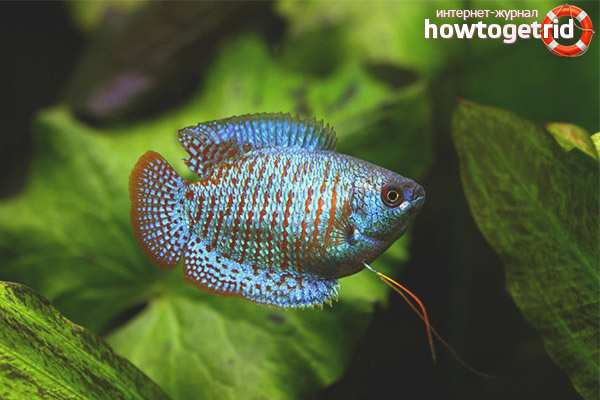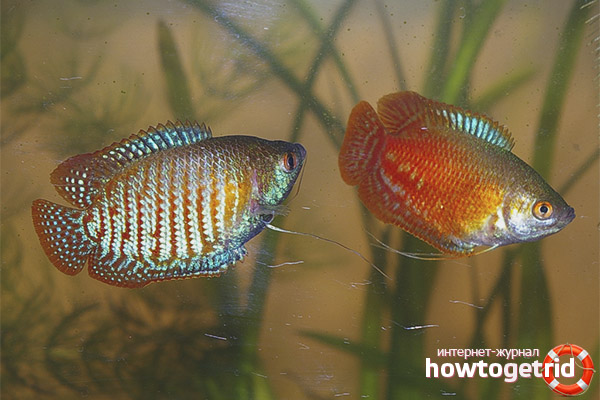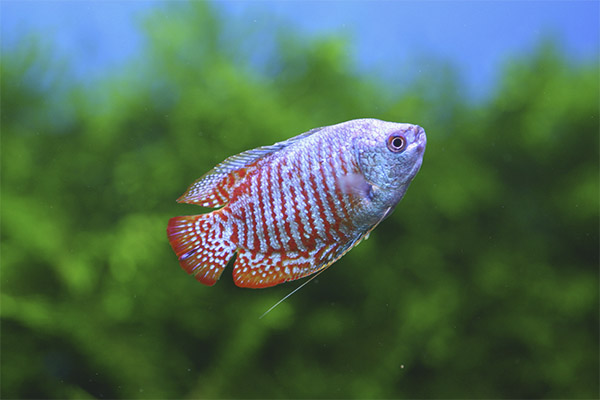The content of the article
Lyalius or Colisalalia is one of the most famous and sought-after breeds of aquarium fish. They gained their popularity due to their peaceful nature, variegated color and their small size. These inhabitants of aquariums grow up to 7 centimeters, and the females are somewhat smaller. These beautiful fish fit perfectly into aquariums of any type and become their decoration. Great for beginner aquarists.
They need a small tank, which has a volume of about 10 liters, but the larger one will be much more comfortable. These fish are very peaceful and able to live with almost all kinds of their relatives. They can be called timid, especially if they are contained in conjunction with more active breeds. As a rule, they do not hurry to eat and often simply do not have time to eat, because the food is eaten by other fish.
They always need a secluded place, so it is important that the bottom of the aquarium is densely populated with plants. Representatives of this species are different fearfulness, they do not like loud sounds, they do not like the bustle.
These are maze fish, they need a certain amount of atmospheric oxygen. Lyaliuses rise to the surface of the water to breathe.
In vivo
South Asia — India, Pakistan, Singapore, Bangladesh — is considered the birthplace of lyalius. This fish was first described in the 33rd year of the 19th century by Hamilton. It was previously assumed that lyalius are found in Myanmar and Nepal, but this is not true. However, today they have been brought to Singapore, the United States and Colombia.
During the period of its fame, this breed of fish was renamed several times. Previously, they were known as Colisa lalia, and in recent years Trichogaster lalius has been used more often.
Their natural habitats are streams, rice fields, irrigation canals, ponds, lakes. They prefer places where there is a lot of seaweed, the outlets of the Ganges River, the Brahmaputra, the Baram River on the island of Borneo.
In its natural environment, everyone goes. Their diet consists of insects, larvae, fry and other sources of animal protein. The fish of this breed has a characteristic feature, it lies in the fact that lalyusi hunt insects that fly over water. Fishes freeze in anticipation of prey when it is in an accessible place, they spit a little water, so they take it out.
Appearance
Lyalius have a narrow body and large fins, rounded shape. On the abdomen, they have thin tentacles that help them navigate the environment.
Lalius males can reach sizes up to 7 and a half centimeters. Females have a shorter length, which is not more than 6. These fish live for about 4 years. But if conditions of maintenance and care are good, then they have a longer life span.
Males have a bright and spectacular color. Their silver body is decorated with blue and red stripes, and the belly is purple. Females look much more modest.
Content Features
As a rule, the fish of this breed are completely unpretentious in the care. They are ideal for those who have no experience of keeping fish in an aquarium. Naturally, some rules still need to be observed, but it is not difficult.It is imperative that you pay some attention to the aquarium and change the water to fresher water in a timely manner.
The tank itself should preferably be in a quiet and comfortable place where the fish will not be much disturbing. After all, they are quite shy, they do not like loud sounds and constant bustle.
Nutrition

Lyalius is an omnivorous fish. Under natural conditions, their diet consists of insects and larvae. They also like to eat algae and zooplankton. In the conditions of the aquarium, they eat any available feed that is offered by the owner. They can be fed live, artificial and frozen. The basis of their diet is preferably flakes that remain on the water. You can further diversify the diet of laliusa with coretra, artemia, and pipemaker.
As for moths, many aquarists with experience tend to believe that it has a negative effect on the digestive system of fish and should not be given. It is worth noting that lyalius are prone to overeating and can get overweight. For this reason, it is necessary to control their food intake.
Living in aquarium conditions
Lyalius can live at all levels of depth, but prefer to stay closer to the surface. For one or two representatives of this breed of fish is quite enough a small reservoir of 10-15 liters. It is better to keep them in larger quantities, respectively, in a larger aquarium.
An important condition is the proximity of the temperature in the room to the temperature of the water in the tank. For the reason that they often rise to the surface for oxygen. A large difference in temperature indices may adversely affect the respiratory system of Lyalius.
Filtration is not desirable. But the main thing is not to have a strong current. Lyalius does not belong to good swimmers and feels much more comfortable in standing water.
These colorful fish look beautiful on a dark background. Therefore, it is preferable to use dark-colored soils. They like to hide in the thickets of algae, for this reason it is better to plant the aquarium with plants, preferably floating. The reservoir should be located in a quiet place.
For breeding you will need one male and several females.If the females are not enough, the male representatives can begin to sort things out. When keeping several males, the reservoir should be spacious enough and have a lot of vegetation.
Lyalius can adapt to any content conditions, but the most optimal are t23 - 28С, pH 6 -8, acidity - from 5 to 18.
Neighborhood
Lyalius should be settled with small and peaceful fish, the same as themselves. The neighbors will annoy and frighten the shy Lalius people with large sizes and high activity. They can spend the first time in shelter from prying eyes, gradually getting used to their new home.
The luliuses themselves are excellent neighbors, but they may suffer from other inhabitants of the aquarium.
They may well be kept in a pair within their species. However, it should be borne in mind that males are prone to show aggression towards females. Therefore, the lady should always have a place to hide.
Gender Differences

The male lyalius is larger and brighter in color. Their dorsal fins are pointed. Females are not so brightly colored, in the area of the tummy they are much rounder and are more timid.
Breeding
When it is decided to breed these fish, they should be deposited in a separate tank. The spawning volume should be about 50 liters. It is filled with water at the level of 15 centimeters. Such a small depth allows the fry to breathe oxygen from the surface of the water. Due to the long-term cultivation of lyalius at home, they adapted to any water parameters. However, it should not be too alkaline.
Spawning must necessarily be planted with live plants. They are required for arranging the nest. A pair of fish settles their nest, which consists of bubbles, and fasten it with pieces of plants.
The temperature of the water in the tank should correspond to the indicators from 26 to 28 degrees. It is necessary to exclude filtration and aeration. It is necessary to provide a shelter for the female where she can hide from an aggressive male.
After grooming, the female lays eggs, and the male is engaged in their insemination. At the end of this process, the female is immediately sent back to the usual tank. And the male fish is left to care for the eggs.
Fry appear in about 12 hours.The larvae are very small in size and for a few more days they do not leave the nest. After 5 days, the fry begin to swim. At this time, the male must be removed. The diet of fry should consist of very small food, suitable ciliates. Food should be given several times a day. It is very important. From lack of food they can simply die.
After a week and a half, you can begin to introduce larger feed, microworms and nauplii, Artemia. Fry must be sorted by size. Often there are cases when larger kids eat smaller ones.
Video: aquarium fish lilius











To send